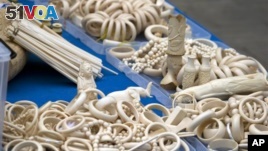June 18,2015
There’s a new weapon in the fight to stop elephant poaching: genetics. DNA testing, which is frequently used to solve crimes, has pinpointed where most of Africa’s elephants are being slaughtered.
The African elephant is the world’s largest land animal and is vital to the environment in which it lives. But the elephant population is shrinking fast, as demand for illegal ivory remains high, especially in Asia.
University of Washington biology professor Sam Wasser and his colleagues conducted the ivory DNA research. They tested samples seized by authorities between 1996 and 2014.

Ivory products are prepared for destruction during a ceremony in Beijing, Friday, May 29, 2015. China's State Forestry Administration and General Administration of Customs officials presided over a ceremony to destroy more than 660 kilograms of ivory that was seized after being smuggled into the country, as part of a crackdown on the illegal trade. (AP Photo/Ng Han Guan)
“We are currently losing an estimated 50,000 African elephants a year to poaching. And there’s only about 470,000 elephants remaining in the population. So, that’s about a tenth of the population being lost each year,” he said.
He said the best way to stop elephant poaching is to stop the demand for ivory. But that’s a long, slow process. So Wasser said efforts must also focus on preventing attacks on the animals.
“Their loss is already causing major ecological and economic damage in Africa, threatening national security. And again, if we do not curb the killing, we are really going to cause serious problems throughout Africa.”
Researchers used DNA to determine the origin of large ivory seizures. They used ivory from 28 seizures. Each weighed a minimum of half a metric ton and worth at least $1 million.
Wasser said, “The size and value of these seizures suggests that these are really involving large transnational organized-crime syndicates. They’re individuals that can afford to lose a million dollars in a single seizure. And what is also important about these large seizures is they represent 70 percent of all ivory that is seized. So, we’re really talking about the majority of ivory being moved around the world.”
Wasser said that over the past decade, nearly all the seized ivory came from just two places in Africa, mostly poached by organized crime. Ivory DNA was compared with DNA found in 1,500 elephant dung samples.
“Virtually, all of these seizures came from just two hot spots. One is for forest elephants, which is in the Triduum area of Central Africa. And that’s northeast Gabon, northwest Republic of Congo and the adjacent Dzanga Sangha in Central African Republic. But the biggest hot spot was in southern Tanzania. Probably two-thirds of the ivory came from there, starting in the Selous Game Reserve — a major protected area in the south — and the adjacent Niassa Game Reserve in northern Mozambique.”
He said as the number of elephants dwindled in those areas, poaching moved toward Ruaha National Park and Rungwa Game Reserve in Tanzania.
He said that the DNA information can help authorities target poachers and “choke the flow of ivory into the complex criminal networks.”
The study said the DNA technique could be adapted to other animals as well, and its accuracy improved. In fact, it could eventually allow authorities to mount coordinated, international responses.
Researchers said the illegal wildlife trade is the world’s fourth-largest organized crime.
Some information for this report came from Reuters.